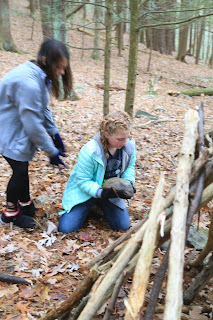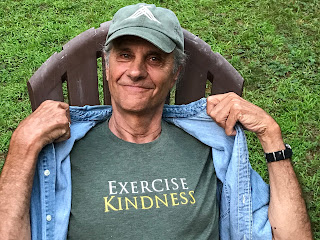Quaker Education is Outdoor Education
Friends schools have an exceptional opportunity
to be leaders in outdoor education.
The moral underpinnings of Quakerism
demand that we educate our students to be stewards
of the natural world.
The powerful history of social change is a model for taking effective
action.
No matter the school's location-- urban, suburban or rural--all
campuses lend themselves to
getting students outdoors.
by Dan Kriesberg, Sixth Grade Teacher, Friends Academy
In my view, there is no better phrasing than to say, we need a
"right relationship" with the earth. For this to happen, outdoor
environmental education must be part of Quaker education. The point of
outdoor environmental education is to help children to gain a greater sense of
place, by giving them experiences that enhance their ability to wonder, to
learn, and to become effective stewards of the natural world. This only
happens with the direct contact that comes from being outdoors. Outdoor education happens outdoors. Catching a frog will always teach more about
that frog than any lecture, movie, website, book or video ever could. In the
past, children spent more time outdoors, but, more recently, overscheduling,
fear, and a lack of places to go have conspired to keep them indoors.
The Quaker testimonies mesh with outdoor education in many ways,
even if the word Quakerism is never mentioned. Living simply is more than
having and using less stuff; it also means finding joy and wonder in simple
pleasures. By becoming more aware of the amazing world that surrounds
them, children can find joy in a place that is not human-centered. Time
spent outdoors makes them more attentive and better able to appreciate their
surroundings. Further, outdoor environmental education is a force that helps
children enhance their sense of wonder. When actively wondering, children
will ask the questions that lead to a more profound understanding of the
natural world, and after raising their awareness to wonder, children will
discover more at which to be amazed, to marvel, to enjoy--all of which come
from being in tune with that which surrounds them. Spending time in the
outdoors, learning about the outdoors, and exploring the outdoors are the only
ways that this can effectively happen. This incredible source of joy
surrounds all of us; it is just that simple.
Visits to national parks are wonderful, but not required, as the natural
world can be observed and explored in backyards, streets, empty lots, forests,
or green spaces. All that is necessary is getting children outdoors.
The power of silence can be felt outdoors as much as it can in any
Meetinghouse. Taking children outside for silent reflection allows
opportunities for the more-than-human world to reveal itself as they become
inhabitants as opposed to visitors. There are also many lessons and
activities that can take place within the environment, that enhance the sense
of wonder, simply by being outdoors.
We are at war with creation. Estimates put the number of
endangered species in the United States at 1,300, and the number lost to human
action is estimated to be at a minimum of one thousand times more than the
average background rate of extinction. The list of environmental
degradation is a long one, but it does not have to be this way. Peaceful resolution of conflict is not
limited to working things out between people; it means finding peace with all
creation. There are many examples of
individuals who have made good choices to solve environmental problems. These
are opportunities to teach children about the successes we have had resolving
conflicts with creation. There are stories in every community of rivers
that are cleaned, endangered species saved, and land preserved. To inspire, more of these stories need to be
told. It is worth reading the local
paper for examples and talking to nearby environmental organizations to find
out what they are doing and how to get children involved. Schools need to get children out of the
classroom for visits to places of success to bring these stories to life.
Schools need to take action to be more sustainable and to celebrate those
initiatives and the results thereof. There are ways to live peacefully with
creation by understanding creation.
We also need to be honest about our impact on nature and have the
integrity to do something about it. We must speak the truth about our power to
damage the environment and come up with ways to save it. By ignoring the
reality, we are all harmed. Truth can be
revealed through science, which is why it is so important to teach children how
science works. One of the fundamental elements of science is that there is a
process. We can all equally add to the collective knowledge of science.
In the outdoors, students can learn observation skills to make models, to
classify information, to design experiments, and to draw conclusions, amongst
other invaluable skills.
The truth-seeking of science and Quakerism have much in common.
Both empower children by showing them that they can learn for themselves
and are not dependent on experts or clergy. Both demonstrate that a
learner must be open to new knowledge and can always learn new things. Both teach the importance of inquiry and encourage
the asking of questions. Both are a search for truth and understanding
through contemplation, observation, experimentation, and experience. Both use gathered evidence to understand
phenomena. Both believe that finding
knowledge is best done in cooperation by sharing insights with others.
With expertise gained, all must act with integrity to make good choices
to care for the land, air, and water.
In the process of being honest about our impact, we must be
mindful of being age appropriate. Too much focus on environmental problems for
younger children can lead to fear and disconnect that will scare them in a way
that will not motivate them toward action or allow them to find joy and wonder
in the natural world. When in doubt, always err on the side of beauty and
wonder.
The scientific definition of community is the interrelationship
between all of the living parts in a given area. But, when we use community to
describe our schools and neighborhoods, do we include the animals and plants
that share our earth? It is time to include all life in our common
definition of community. Everything is connected, and through outdoor
environmental education, children will see these interrelationships
firsthand. Taking children outdoors to
learn about the members of their community provides opportunities to know about
them, and the more connected they are to them, the more likely they will be to
care for them. Understanding ecological interrelationships provides an
explanation for what, why and how the earth works and where we fit in.
This is why it is essential to know the names of common plants and
animals in our communities. We need to celebrate the local flora and fauna;
amazing flora and fauna are not limited to jungles and deserts, or other
faraway places. With the outdoors as your classroom, you can help children
appreciate the ecological interrelationships that allow life on earth to exist
and to understand their place in this incredible creation.
It is essential to come in contact with plants and animals in the
wild whenever possible. Allowing students to dig into the soil to find
all those creepy, crawly creatures is an opportunity to engage students with
life. Even if a child doesn't want to hold a worm, after learning about them in
their real-world environment, they may think twice before stepping on one.
Sitting still and watching a bird sing helps to see that bird as an
individual with its own life to live. No
matter what, humans are going to have an impact, but the choice we do have is
to limit our impact by continually reminding ourselves that all lives have
value. As a bonus, outdoor education is
best taught in cooperative groups; activities like digging for worms or
listening to birds, become moments where children engage with one another when
all have equal space to contribute and to learn.
The result of outdoor environmental education done right is
children who will have the motivation, knowledge, and skills to be effective
stewards, stewardship that goes beyond just using reusable water bottles and
shopping bags. To be faithful stewards and take action as Quakers have in
the past, it takes personal responsibility in conjunction with holding our
government and business leaders accountable for their actions. This is the way to more success stories.
Friends schools have an exceptional opportunity to be leaders in
outdoor education. The moral underpinnings of Quakerism demand that we
educate our students to be stewards of the natural world. The powerful
history of social change is a model for taking effective action. No matter the
school's location-- urban, suburban or rural--all campuses lend themselves to
getting students outdoors. Our schools also have the gift of more
flexible curricula. Time for outdoor
environmental education should not be pushed out by curricular pressures, as it
can be integrated into many aspects of school life because outdoor education is
part of every discipline.
By basing outdoor environmental education in the awareness of
wonder and beauty, children will gain a greater sense of place. As they learn
more about the ecological systems and how to take action, they gain the
knowledge and skills to make a difference. With stories of successes, children
are given hope and motivation that problems can be solved. Outdoor
environmental education makes the testimonies real. It is a way to walk the
talk.




Get the Scoop on The Outdoor Force Before You're Too Late
ReplyDeleteThe outdoor force
Positive site, where did u come up with the information on this posting? I'm pleased I discovered it though, ill be checking back soon to find out what additional posts you include. Intex Explorer K2 Kayak
ReplyDelete